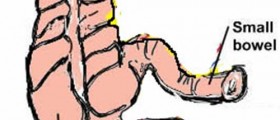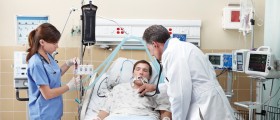
The appendix is a small organ whose shape reminds of a finger. It is located in the abdominal cavity and has no real function in the human body. Appendicitis is the inflammation of the appendix which inevitably ends up with a surgical removal of the inflamed appendix. Second complication with appendix is a burst appendix which could lead to death if it goes untreated.
Symptoms
One of the first and most common symptoms is pain in the abdomen. The abdominal wall becomes sensitive to touch. The pain is very sharp and stabbing and it extends from the belly button to the right hip area. The pain is sudden and becomes worse hour after hour. In case a person coughs, sneezes or breathes deeply, the pain worsens. In the case of appendicitis, the pain is intermittent, but in the case of a ruptured appendix the pain is constant and cannot be relieved. Another common pain is high body temperature. In the first phase, when the appendix is only swollen, a person may get mild fever, but when the condition worsens and an inflammation develops, when the appendix bursts, the temperature of the body rises. Another sign that a person may want to visit a doctor is changed bowel movement. It is possible that diarrhea or constipation occur. A person may even feel nausea and starts to vomit. Abdomen becomes swollen and a person feels bloated. The appetite is lost so the person does not feel hunger.
Causes
According to experimental evidence, appendicitis is caused by the obstruction of the appendix. When this occurs, mucus is accumulated in the appendix which as a result swells and comes under great pressure. This blockage of the appendix causes thrombosis of the small vessels and discontinuation of the flow of the lymph. It is possible that bacteria start flowing out of the walls of the appendix. This condition usually ends up as a burst appendix which is a life threatening condition. Obstructing mucus can be caused by a trauma, intestinal worms and other kinds of deposits. Fecal stasis may be the cause for appendicitis because people who have that problem have much lower number of bowel movements that those who are healthy. Some studies have shown that nutrition poor in fibers can lead to appendicitis, and to a burst appendix in the end.
Diagnosis and treatment
Diagnosis is determined according to the patient\'s symptoms and the blood test in which white blood cells are monitored. Typical appendicitis is determined without any doubt thanks to the recognizable symptoms. A typical appendicitis, however, does not have the typical progression so they require ultrasound or CT scanning. The only treatment is surgery in which the ruptured appendix will be removed. The risk of complications during the surgery is almost 59%, and the most common complications are hernia, pneumonia, bleeding and adhesions. The laparoscopy, surgery with a small incision and whit a camera, is not possible in case of ruptured appendix. It is a very complicated surgery because the pus that accumulated in the appendix and which is merely a body\'s way to protect itself from illness, has to be drained out to prevent spreading of the infection. It is necessary to administer the patient the antibiotics he or she will probably take for weeks after the surgery. Most patients fully recover after the surgery. Recovery period lasts from 10 days for adults to three weeks in children around ten years of age.

















Your thoughts on this
Loading...